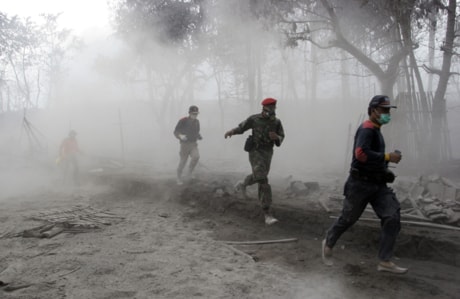MOUNT MERAPI, Indonesia — Searing gas avalanched down an Indonesian volcano with a thunderous roar, torching houses and trees and incinerating villagers as they fled Mount Merapi’s worst eruption in a century. Scores of bodies found Friday raised the death toll to 122.
The injured — with clothes, blankets and even mattresses fused to their skin by the 750 degree Celsius heat — were carried away on stretchers following the first big explosion just before midnight.
All Friday, Merapi shot towering plumes of ash that dusted the windshields of cars 480 kilometres away. Bursts of hot clouds occasionally interrupted aid efforts, with rescuers screaming “Watch out! Hot cloud!”
The intensifying eruptions have baffled scientists who have monitored the mountain for years and left them uncertain what to expect. Dozens of explosions that followed Merapi’s initial blast Oct. 26 had been predicted to ease pressure behind a magma dome.
The danger zone where residents have been ordered to flee has now been expanded to 20 kilometres from the crater.
Friday’s explosion — said by volcanologists to be the biggest since the 1870s — hit hardest in Bronggang, a village 15 kilometres from the crater. Soldiers joined the rescue operations, pulling at least 78 bodies from homes and streets blanketed by ash up to 30 centimetres deep.
Crumpled roofs, charred carcasses of cattle and broken chairs — all layered in white soot — dotted the smouldering landscape.
The volcano, in the heart of densely populated Java island, has erupted scores of times in the past, killing more than 1,500 people in the last century alone. But tens of thousands of people live on its rolling slopes, drawn to soil made fertile by lava and volcanic debris.
“The heat surrounded us and there was white smoke everywhere,” said Niti Raharjo, 47, who was thrown from his motorbike along with his 19-year-old son while trying to flee.
“I saw people running, screaming in the dark, women so scared they fell unconscious,” he said from a hospital where they were both being treated for burns.
“There was an explosion that sounded like it was from a war ... and it got worse, the ash and debris raining down.”
The greatest danger posed by Merapi has always been pyroclastic flows — like those that roared down the southern slopes at speeds of up to 100 kilometres per hour.
With bodies found in front of houses and in streets, it appeared that many of the villagers died from the searing gas while trying to escape, said Col. Tjiptono, a deputy police chief.
More than 150 injured people — with burns, respiratory problems, broken bones and cuts — waited to be treated at the tiny Sardjito hospital, where the bodies piled up in the morgue, and two other hospitals.
“We’re totally overwhelmed here!” said Heru Nogroho, a spokesman at Sardjito.
In terms of the amount of volcanic material released — 50 million cubic meter, “it was the biggest in at least a century,” Gede Swantika, a state volcanologist, said as plumes of smoke continued to shoot up more than 10,000 metres.
More than 100,000 people living along Merapi’s fertile slopes have been evacuated to crowded emergency shelters, many by force, in the last week. Some return to their villages during lulls in activity, however, to tend to their livestock.
They were told to stay away Friday. The government also announced an $11 million program to buy the cows on the mountain to keep farmers off its slopes, and to provide compensation for animals lost in the eruptions.
Even scientists from Merapi’s monitoring station were told they had to pack up and move down the mountain. They were scrambling to repair four of their five seismographs destroyed by the heavy soot showers.
Before Friday, the death toll from Merapi stood at 44, with most dying in its first blast on Oct. 26. With the new deaths around Bronggang it climbed to 122, the National Disaster Management Agency said.
In 1994, 60 people were killed by Merapi, while in 1930, more than a dozen villages were torched, leaving up to 1,300 dead.
Indonesia, a vast archipelago of 235 million people, is prone to earthquakes and volcanos because it sits along the Pacific “Ring of Fire,” a horseshoe-shaped string of faults that lines the Pacific Ocean.
The volcano’s initial blast occurred less than 24 hours after a towering tsunami slammed into the remote Mentawai islands on the western end of the country, sweeping entire villages to sea, killing at least 428 people and severely taxing Indonesia’s relief services.
There, too, thousands of people were displaced, many living in government camps.
